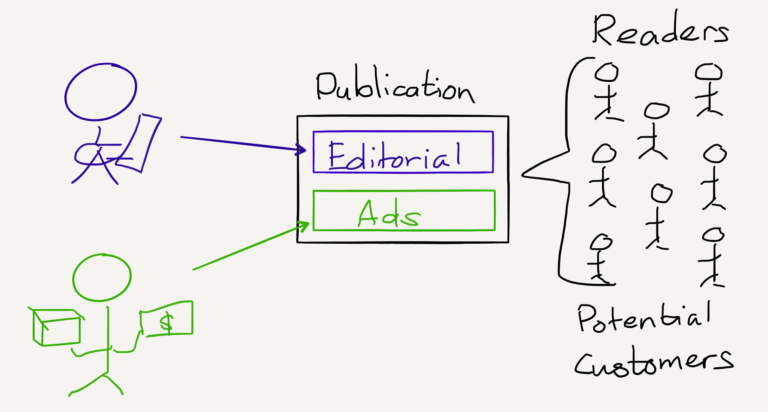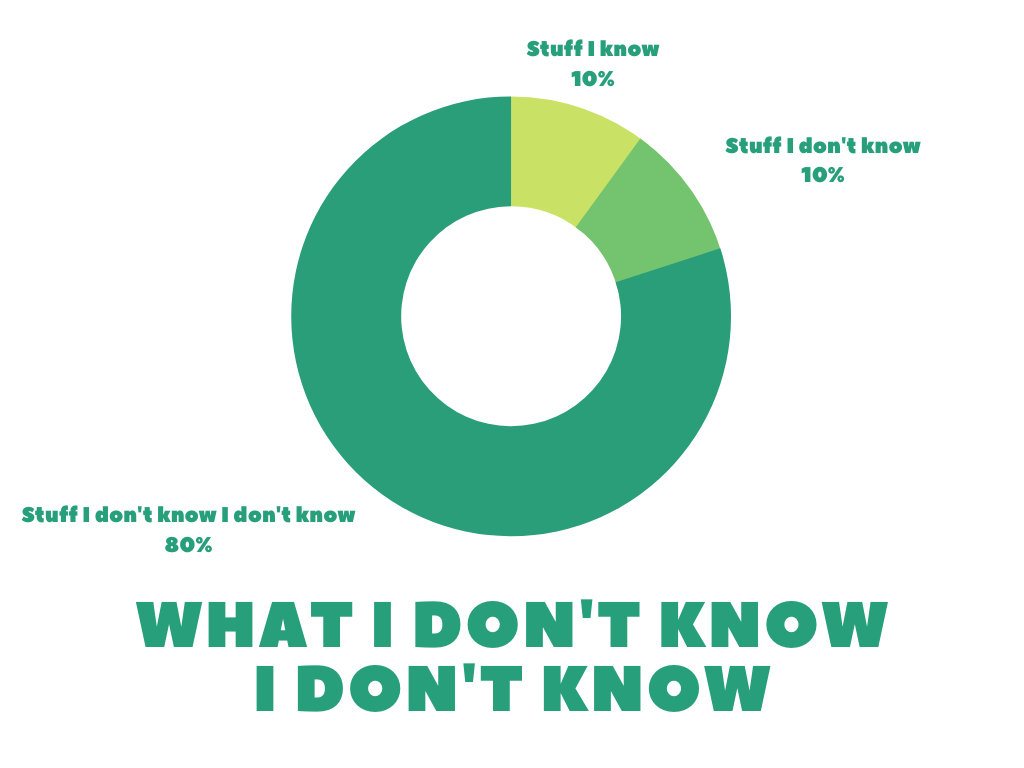Update #4: The back-of-an-envelope business model
Friday, August 28th, 2020
Shane here again.
As part of the “build in public” model, I promise to send a Friday note to everyone who signs up for the Magnificent Irrelevance email list. This is the fourth update.
Pre-Launch Email List Sign-up Update
Okay, so I knew this would happen. I just didn’t think it would happen so quickly.
This week the troublesome voice on my shoulder started speaking up. It was loud.
Why the hell are you doing this?
Who are you doing this for?
Why don’t you give up now before you’re in too deep?
I’d been expecting this. Maybe not so soon, but I was prepared. Sorta.
Just a few dozen visits to the site this week, and one new sign-up.
Putting stuff out into the world never feels easy. Part of my mind, and right now it’s a big part of my mind, is fearful of judgment. No-one likes to fail in public. Failing at something always seems much easier to handle if you fail behind closed doors, with no-one watching.
Thanks to everyone who has signed up so far.
This week has been a slow one on the site visitors and sign-ups front.

Over the past week there have been 32 visits to the website … resulting in just the one new sign-up.

Again, thank you to all of you for being here.
This Week: The Business Model
Magnificent Irrelevance is a business, so it’s getting treated like a business.
Right now it’s a business with zero customers and 20 early sign-ups who have expressed some interest in hearing about where this might go.
But that doesn’t mean it shouldn’t be treated like a business. And all businesses need a business model.
This, for now, is the draft business model for Magnificent Irrelevance, in bullet points.
- A very brief history of media business models: Ad-supported media is the norm. For well over a century, the primary business model for media was ads plus cover price sales. There was an invisible but solid wall between those two sides of the business (“the separation of Church and State”). Editorial sold news, or features, or content, or whatever label you might give to the meat on the bones, and the ad men sold advertising to go around the meat. But as people like Stratechery’s Ben Thompson have outlined, the old and well-worn media model became unworkable in the Internet arena:
The shift from paper to digital meant publications could now reach every person on earth (not just their geographic area), and starting a new publication was vastly easier and cheaper than before. This had two critical implications:
- There was now an effectively unlimited amount of ad inventory, which meant the price of an undifferentiated ad has drifted inexorably towards zero
- “Readers” and “potential customers” became two distinct entities, which meant that publishers and advertisers were no longer in alignment
This first point is obvious and well-known, but the importance of the second can not be overstated: publishers had long taken advertising for granted (or, as the journalists put it, had erected a “separation of church and state”) under the assumption they had a monopoly on reader attention. The increase in competition destroyed the monopoly, but it was the divorce of “readers” from “potential customers” that prevented even the largest publishers from profiting much from the massive amounts of new traffic they were receiving. After all, advertisers don’t really care about readers; they care about identifying, reaching, and converting potential customers. And, by extension, this meant that differentiating ad inventory depended less on volume and much more on the degree to which a particular ad offered superior targeting, a superior format, or superior tracking.
This bifurcation in incentives has resulted in a plethora of ad networks … The result is that ad networks don’t really care about the readers — which is a big reason Why Web Pages Suck — and on the flip-side publishers don’t really care about the advertisers, resulting in click fraud, pixel stuffing, ad stacking, and a whole host of questionable behavior that is at best on the edge of legality and absolutely not in the advertisers’ interest.
As with any other company or industry built on fundamentally misaligned incentives, this is unsustainable.

From Stratechery, “Popping the Publishing Bubble”
- Three revenue options: Given that the business needs to find a way to pay for itself, and there is no prospect of any capital injection in the near future, there are a number of options available to make this work:
- First, free and fully ad-supported, which needs a consistent and steady high volume of visitors, the type of content and content distribution mechanisms that attracts a consistent and steady high volume of visitors, and the time required to turn those visitor numbers into ad income.
- second, zero ads, and therefore based on recurring monthly or annual subscriptions from readers or members;
- or third, some hybrid mix of the two.
- “Ads aren’t cool”: That’s a line from The Social Network, the 2010 Aaron Sorkin movie, attributed to (if I remember correctly) a younger Mark Zuckerberg. Zuck is now at the helm of the biggest ad empire in the history of humanity, effectively printing cash on demand from a combination of adtech software wizardry and 2-point-whatever-billion user base, all of whom can become advertisers in the time it takes for them to punch in their credit card number. A decade later, ads are still not cool. Even worse, the vast majority of ad dollars spent go to two massive Internet companies, Facebook and Google. One of the paradoxes of the Internet is that just as Facebook, Google and other platforms have allowed media organisations to reach millions or tens of millions of people around the world with their content, they have eroded the business model that makes those organisations long-term sustainable.
- The Internet economy: A few weeks ago I listened to a podcast interview with my fellow Irishman, John Collison. Being Irish and sometimes spending time on the Internet are maybe the only things I have in common with John Collison. The co-founder of iconic payments company Stripe, Collison spoke about the Internet economy
The Internet economy is a very small fraction of the overall economy, depending on who you believe — 5%, 6%, something like that — but the vast majority of economic activity is not Internet-enabled. I think it’s fairly clear to all of us that that is going to flip. We’re going to end up with actually a majority that’s Internet-enabled, but that means we’re really at a shockingly early point in that sigmoid growth curve.
- Subscription models: Many people now are getting more and more comfortable with subscriptions, whether it’s Netflix or NOW TV or Amazon Prime. The media publishing world, however, is fighting a paywall battle many of those organisations might not be able to win. For 20 years or more, media organisations have flitted from free to paywall to a mix of the two. Now, a so-called “leaky paywall” or freemium model is the norm in many cases, with readers able to access a small number of articles or pieces of content each week or month before being invited to subscribe. But there is a hard limit on the number of general media organisations that many people will subscribe to. Most will subscribe to none, and for those who are happy to break out the credit card, perhaps they will be happy to make one or a few monthly payments of €10 or £20 or $30. But there’s a strong and growing trend away from general media to much more niche or specialist avenues, so the Financial Times, say, can target and serve a specific and relatively small subset of the populace for a £300 per annum, and the likes of Stratechery and a growing cast of micro-niche bloggers can charge for dedicated and specialised interest, while general interest national broadsheets struggle to stand out from the crowd and convince readers of the value in what they do. That doesn’t mean the landscape is necessarily good or bad. It just is. People’s behaviours and attitudes change over time, and many more traditional media organisations are feeling the brunt of that change now, no matter how much they try to make up for lost digital ground.
- Three apparent trends: All this is to say that the trends seem to suggest three things. (1) That people are becoming more comfortable with subscriptions. (2) That niche interest outlets might reach a much smaller percentage of the general audience, but in an age of limitless distribution, that niche might be more than big enough to make it pay. And (3) that general or broad interest media organisations might struggle to distinguish themselves from one another in an age when news, irrespective of how expensive it is to produce, is increasingly seen as free. The vision for this site, wherever and whatever it might become, and however that happens, is a niche interest that a relatively small number of people around the world will see sufficient value in to pay for, but that relatively small number of customers might still be a big enough cohort to make the boat float.
- 5,000 customers. That’s the milestone number for Magnificent Irrelevance as a break-even point. To my mind, this venture needs an absolute baseline minimum of €25,000 per month to deliver the sort of quality stories and reading experience that exists in some deep ravine in my mind’s eye. Yes, that figure is little more than a back-of-an-envelope exercise. But there aren’t so many moving parts. The baseline break-even point will cover all production and promotion, from the technicalities of keeping a web server secure and fast, to the writers and editors and photographers and illustrators that might work on any given piece, to the behind-the-scenes administration that makes everything possible. That’s with no full-time staff, no full-time office space, no dividends or director remuneration of any kind, and not much room for the indulgent experimentation that might help it advance another level or two or three forward. 5,000 customers at an average payment of €5 a month, as a break-even point. Above and beyond that, let’s see where it goes. Of course it’s possible, but I’ve no idea whether I can make it happen. I know lots about the industry, but equally there is a lot I know I don’t know, and maybe the biggest area of the pie chart is the stuff I don’t know I don’t know. Ignorance is bliss, until the day the truth about that ignorance becomes obvious. More on that day when it happens…

That’s all for this Magnificent Irrelevance build in public weekly update.
If you’d like to receive these updates each Friday by email, make sure to sign up here.

Leave a Reply
Want to join the discussion?Feel free to contribute!